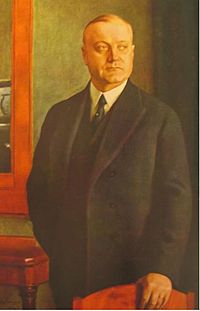Rudolf Walden - Picture
More about World War 1

|
|
Rudolf Walden

Picture - by Eero Jx¤rnefelt in 1929 - UPM-Kymmene collection
Karl Rudolf Walden (December 1, 1878, Helsinki - October 25, 1946) was a Finnish industrialist and general.
He received his military education in Hamina Cadet School 1892-1900. He was dismissed from service in 1902, in connection with a conscription strike. After leaving the army Walden sought a career in business. He moved to Saint Petersburg, the capital of Tsarist Russia, and after few years managed to create a major sales agency for Finnish paper. As a steadfast patriot Walden also became a prominent figure in the large Finnish community of Saint Petersburg.
In the Finnish Civil War (1918) he served as:
the Chief of Vaasa military district from 20 February till March 5;
Chief of Rear Area of the headquarters from 5 March till 6 May;
Chief of Security of the occupied areas from 6 till 22 May
Minister of War from 28 November, 1918 till 15 August, 1919;
Commander-in-Chief of the Finnish Army and of the Civil Guard from 27 November till 30 December, 1918.
Walden was in the management of paper industry during 1906-1946. He acted as a consolidator of the Finnish paper industry, founded Yhtyneet Paperitehtaat Oy (United Paper Mills Ltd) and was the first president of Finpap, a Finnish paper sales association.
During the Finnish-Soviet Winter War, he was a representative of the headquarters in the Cabinet from 3 December, 1939 till 27 March, 1940. Minister of Defence from 27 March, 1940 till 27 November, 1944. Greatly influential during the war, member of the so-called inner circle, he maintained politically important relationships with Sweden and the United States.
During the Winter War the general distrust for the patriotism of the Finnish workers and labour movement proved unfounded. Nation was united against the foreign aggression. Also the prominent industrialist Rudolf Walden and the Social Democrat leader and Finnish foreign minister Vx¤inx¶ Tanner personally understood each other very well. In January 1940 the Industry Associations acknowledged trade unions as negotiation partners regarding labour issues.
Walden was a close friend and co-operator of Carl Gustaf Emil Mannerheim since the Civil War.
Walden was well known as a tough and cool negotiator. He had represented Finland in negotiation of all peace treaties between Finland and Soviet Union: Treaty of Tartu of 1920, Moscow Peace Treaty (1940), Armistice treaty of Moscow (1944)
Decorations
During his private and public career Walden was decorated with wide variety of domestic and foreign military and civilian awards. In 1919 Walden became a Commander of the Order of the White Rose. Later he received the Grand Cross of the Order. For his services during and after the Finnish Civil War he was awarded the Grand Cross of Liberty. He was also awarded the Iron Cross (1918).
During the 1920s Walden became a knight of the Order of the Polar Star of Sweden and in 1928 Walden received the Danish Grand Cross of the Order of the Dannebrog personally from King Christian X.
During his service as the Minister of Defence, Walden received several high decorations such as the Swedish Order of the Sword, the German Order of the German Eagle and Iron Cross (1939) 1st and 2nd class, the Hungarian Grand Cross of Order of Merit, and the Romanian Grand Cross of Order of the Star.
On 2nd of December 1944 he received the Mannerheim Cross of the Order of the Cross of Liberty for his services to the country.
Russification of Finland
Finnish Civil War
Pulp and paper industry
Winter War
Spirit of the Winter War
Continuation War
More aircraft.
Source: WikiPedia